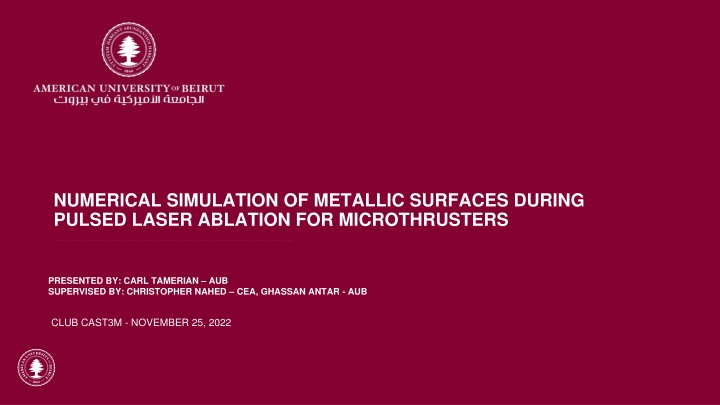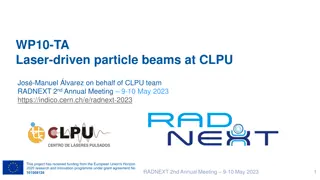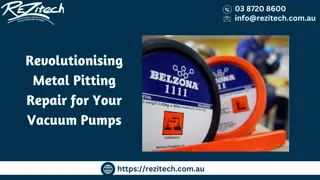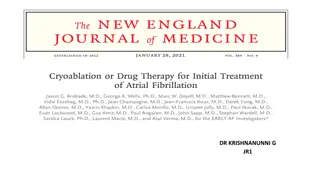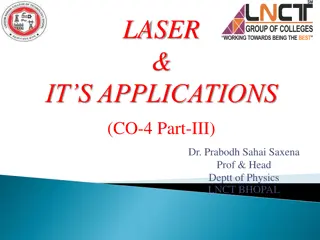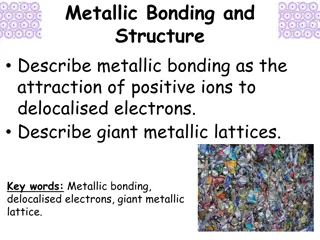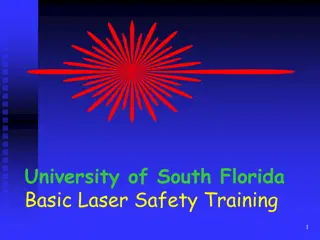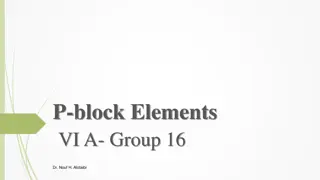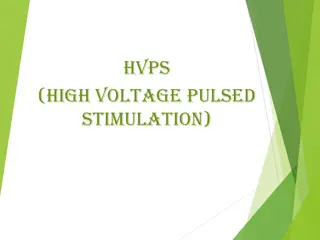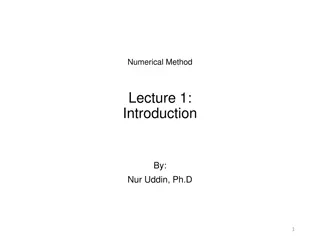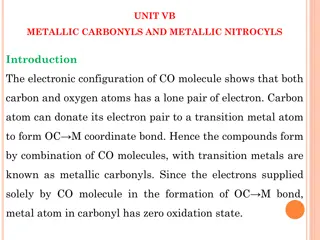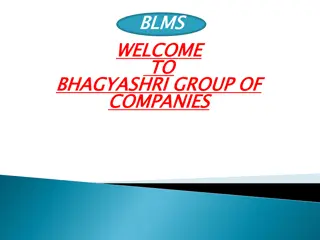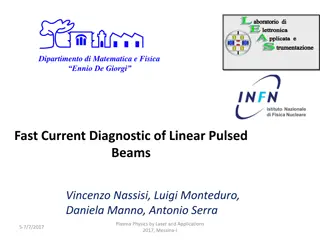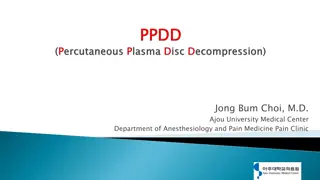Numerical Simulation of Metallic Surfaces During Pulsed Laser Ablation for Microthrusters
This study explores the numerical simulation of metallic surfaces undergoing pulsed laser ablation for microthrusters. Carried out by Carl Tamerian from AUB under the supervision of Christopher Nahed from CEA and Ghassan Antar from AUB, the research delves into the underlying physics of laser ablation. The presentation was given at the CLUB CAST3M on November 25, 2022.
Download Presentation

Please find below an Image/Link to download the presentation.
The content on the website is provided AS IS for your information and personal use only. It may not be sold, licensed, or shared on other websites without obtaining consent from the author.If you encounter any issues during the download, it is possible that the publisher has removed the file from their server.
You are allowed to download the files provided on this website for personal or commercial use, subject to the condition that they are used lawfully. All files are the property of their respective owners.
The content on the website is provided AS IS for your information and personal use only. It may not be sold, licensed, or shared on other websites without obtaining consent from the author.
E N D
Presentation Transcript
NUMERICAL SIMULATION OF METALLIC SURFACES DURING PULSED LASER ABLATION FOR MICROTHRUSTERS PRESENTED BY: CARL TAMERIAN AUB SUPERVISED BY: CHRISTOPHER NAHED CEA, GHASSAN ANTAR - AUB CLUB CAST3M - NOVEMBER 25, 2022
01. 02. CONTENT Overview of Laser Ablation Underlying Physics 04. 03. Experimental and Numerical model Numerical Methods 05. Simulation Results
1.1 OVERVIEW OF LASER ABLATION Laser-induced mass removal from an irradiated zone of a target material. Causes rapid heating and phase change from solid to liquid to gas. Laser pulses are classified into ultrashort and nanosecond pulses. Used in various manufacturing fields including surface processing, welding applications; and aerospace propulsion technologies.
1.2 MICROTHRUSTERS BASED ON PULSED LASER ABLATION Microthrusters can provide very small and accurate thrust forces to maneuver microsatellites They are characterized by their small volume and mass, low power requirements, and high specific impulse Working principle: - Energy from the laser photons heats up the irradiation zone causing rapid phase change from solid to liquid to gas. - The gas transforms into plasma once the ionization energy is exceeded. - The recoil force at the surface propels the system as per the momentum conservation principle.
2.1 GOVERNING EQUATIONS For nanosecond pulsed lasers, continuum heat transfer theories apply at this scale. ??(?,?,?,?) ?? Heat flux equation over a constant control volume ?: ? ? ??? ? ? ? ?,?,?,? = ?(?,?,?,?) Heat input absorbed by the material: ? ?,?,?,? = ? 1 ? ??(?,?,?)? ?? Boundary conditions: - Initial condition: ? ?,?,?,0 = ?0 - Radiation at upper surface: ? ? ?? = ?(?)?(?4 ? 4) - Adiabatic at other surfaces: ? ? ?? = 0 - OR isothermal at other surfaces: ? ?,?,?,?? = ?0
2.2 SOLID LIQUID PHASE CHANGE Isothermal Phase Change Phase Change over Mushy Zone For idealized materials and pure metals For metals with impurities or alloys
2.3 ONCE ABLATION IS INITIATED Once the boiling point of the material is exceeded, ablation is initiated, and surface material is removed. Depending on the laser intensity, ablation might be due to surface evaporation alone or coupled with phase explosion. The ablation rate (recession velocity) due to surface evaporation is represented by the Hertz-Knudsen relation: Ablation depth is calculated by integrating the ablation rate over time
? ???? 2.4 RECOIL FORCES Gas/Plasma region ???? ?? ? Liquid region ? ??????? The total recoil momentum is due to two contributions: pressure exerted by gas/plasma plume on the material and the pressure at the gas/liquid interface. ????= ????????, where ????= ??+ ??? ? The pressure is discontinuous at the liquid-gas interface Using the momentum conservation equation across ? : ?.?. ?.? ??? ?.?. ?.? ? ??? ? = ?? + ? ?? + ??? 2 ??????= (???? ???????).? 3 ? ????= ????? ???????= ???????? ????,??= ???????? ? 0 (? 0) 2 ??????? ? ???? Applying the mass conservation equation along ? : ????=
3.1 INTRODUCTION TO NUMERICAL METHODS Difficulty obtaining analytical solutions of our heat transfer model due to: - Complex material laser plasma interactions - Phase change - Thermophysical properties of the material are temperature dependent Use of FEM to discretize the heat equation in space and time
4.1 OVERVIEW OF OUR PROJECT Goals: Compute the ablation depth, the recoil force at the interface, and select the optimal material. Numerical model: Simulate the ablation phenomenon on CAST3M - Obtain the temperature evolution profiles at critical points while accounting for phase change - Account for material removal once ablation is initiated - Compute the ablation depth and recoil force - Compare the performance of three metals: lead, copper, and aluminum Experimental model: Conduct the PLA experiment at AUB Physics department Fluid dynamics & Plasma lab - Measure the crater size to validate the numerical model - Measure the recoil force using an interferometer
4.2 EXPERIMENTAL MODEL Interferometer: - Sensor that measures micronewton thrust by measuring the speed or displacement of the target. - The splitting and recombination of beams results in an interference pattern. - A high-speed camera captures the interference pattern to analyze the central fringe intensity and direction in which the fringes are moving. - The absolute displacement could be calculated from the phase shift of the sinusoidal mapping of the intensity. Setup: - Vacuum chamber: lower tube connected to vacuum pump; right tube holds the pendulum with the target at the center; other tubes for observation purposes. - Pendulum stand which holds the mirror on one end and the target material is on the other.
4.3.1 NUMERICAL MODEL: CONDITIONS ? = ? = ? The material has a volume of 1mm * 1mm * 10?m 2D simulation in x and z with material size of 0.5mm * 10?m Mesh size: 1.25?m along the horizontal, variable 10nm 500 nm along the vertical Timesteps: 5e-12 s Initial Boundary condition: ?(?,?,?) = ?? ??? Adiabatic boundary conditions: ?? = ? ?=? ??? ?? = ? ?=? ??? ?? = ? ?=?
4.3.2 LASER PROFILE ? ?,?,?,? = ? 1 ? ??(?,?,?)? ?? ???? = 20 ?? Assuming that the laser irradiance is equivalent to the laser intensity UV laser with ? = 308 ?? The laser intensity can be fitted into a Gaussian distribution which varies exponentially in space and time ? ?02 2?? ? ?02 2?? ? ?02 2?? 2 2 2 ???,?,? = ?0? ? ? ? Given the energy per pulse: ?0= ??= 10 4? 2?3/2?????? A laser with a smaller irradiation radius or smaller FWHM results in a larger intensity
4.3.3 THERMOPHYSICAL AND OPTICAL PROPERTIES OF DIFFERENT METALS LEAD ALUMINUM COPPER ? (? ?) 1.148 10 8 1.5025 10 8 1.0168 10 8 ? 0.8917 0.927 0.522 ??(?) 600.61 933.61 1357.77 2.32 104 3.96 105 2.04 105 ??(?) 8810 0.428 ? 293 6.12 10 5? 2933,? < ?? 9109.7077 0.8194 ? , 11345 0.959 ? 293.15 3.715 10 5? 293.152,? < ?? 10651 1.262 ? ?? + 4.62 ? ?? 2700, ? < 600 ? > ?? ? (??.? ?) 2648 + 0.332 ? 4.99 10 4?2, 2670 0.267 ? , 2, 600 < ? < ?? ? > ?? ??< ? < 2000 116.41 + 4.24 10 2? 3.32 10 5?2,? < ?? 167.72 3.92 10 2? + 1.307 10 5?2,??< ? < 1500 210.367 9.609 10 2? + 3.203 10 5?2,1500 < ? < 2400 ??(?.?? ?.? ?) 370.87 + 0.108 ? 4.649 10 5?2+ 2.8045?3, 527.872 , 643.9 + 0.5203 ? ,? < ?? ,? > ?? ? < ?? 1160 ? > ?? 226.67 + 0.033 ? 226.67 0.055 ? ,400 < ? < ?? 1 12.47 + (1.36 10 2 ?) ,? < 400 35.49 1.82 10 2(? 293.15) 9.2 + 0.011 ? 418.775 0.075 ? , 89.7 + 0.04976 ? , ? < ?? ? > ?? ,? < ?? ?(?.? ?.? ?) ,? > ?? 2.45 ? ,? > ??
5.1 RESULTS FOR LEAD S-L Phase Change
5.2 COMPARISON OF TEMPERATURE CURVES OF LEAD, COPPER, AND ALUMINUM ?? ?? LEAD ALUMINUM COPPER
6.1 CONCLUSIONS Lead proves to have the optimal performance among copper and aluminum. Thermal Response: - ??,??< ??,,??< ??,,?? - ??,??< ??,??< ??,?? - ???< ???< ??? ?? ?? ????< (??)??< (??)??, where ?? = 2represents the heat conduction through the material relative to the heat stored - Recoil Force and Ablation Rate: - ???,???is the largest which results in a larger recoil force at the interface - ???is the largest which results in the greater ablation rate
6.2 FUTURE WORK Verifying the results obtained via comparison with other time-integrator programs Adding radiation as a boundary condition on the upper surface Accounting for the gas phase and material removal Calculating the instantaneous ablation rate to compute the ablation depth Computing the recoil force at the interface Comparing the simulation results with the experimental outcomes Level-set method to capture the solid, liquid, and gas/plasma phases simultaneously
